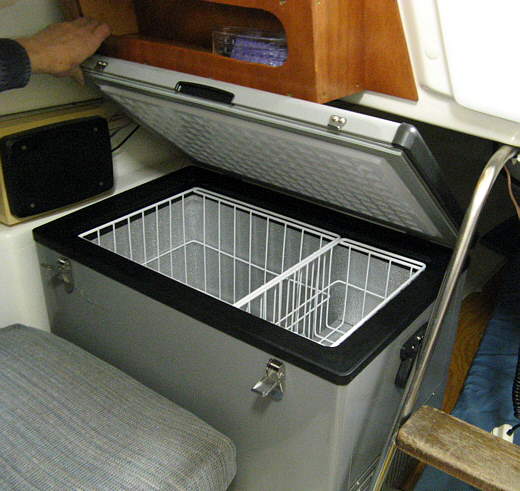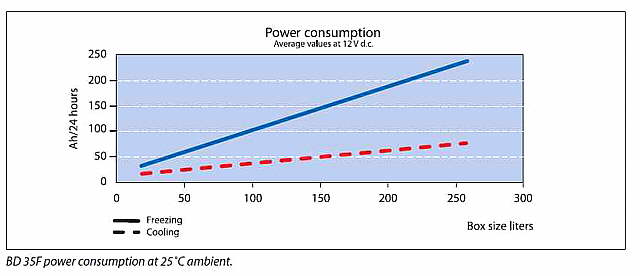..................
.....--- Using Portable Cooler/Freezer to Make Ice ---
..............
Often on the Internet boards someone will bring up the
idea of making ice with one of the portable cooler/freezers (that can run as a cooler or freezer). Then putting
the ice produced into an ice chest type cooler and also trying to use the portable freezer that is making the ice
as a freezer for frozen food.
Will this work? Is it a good idea even if you can make Ice. Lets look at some numbers. It takes a lot more energy
to convert water into ice vs. keeping ice frozen. If you put 1 lb. of 62 deg. water into the fridge you will have
to have a 30 BTU loss to lower it to 32 deg. water. Then you will have to remove 144 BTU's to change that water
from 32 deg. water to 32 deg. ice. So it will only take a 1 BTU loss to get it from 33 deg. to 32 deg. but a 144
BTU loss to change it into ice. After that it takes 1/2 of a BTU loss to continue lowering it 1 deg. For more on
that you can go to the link ( HERE
).
In real life people have found that the ice is going to melt faster in the cooler than it is going to be frozen
in the freezer usually and then the freezer is going to probably run 24 hours a day trying to make that ice which
will also mean you need a lot more electricity vs. if the cooler was cycling on and off as a cooler.
With the above in mind I decided to see for myself what if it was feasible to make ice to use in a cooler. We have
an EdgeStar 63 quart that as far as I can tell is as efficient as any of the other portables out there, even the
name brand ones. Using it in Florida during Nov./Dec. and again in Mar./Apr./early May we found it to use 30-40
amp-hrs/day. Less in the cooler months and more as the cabin temps rose into the 80's later in the trip. It was
used only as a cooler and we usually added about four 12 oz. cans of pop/beer to it a day and other food on the
times we went ashore. It was set to about 36 deg. and I'd turn it off at night which I don't think we will do in
the future.
In the morning at the end of the trip with the warmer cabin temps it would climb to about 44-45 by 8 am after being
off all night. We would turn it on and it would run continuous all day to around 5-7 p.m. to work its way back
down to 34 deg. It was usually packed with food/drinks so there was a lot of thermal mass that had to be cooled
back down. If you turn this fridge on empty and it is around 70 deg. it will be down to zero in less than 2 hours
but that is empty.
So at the end of the trip the fridge was running about 10 hours of the day or 40% of the time in a 24 hour period
which is about what you read for these coolers. In the fall it was around 30% of the time. While running it draws
about 3 1/2 amps so 10 hr. X 3.5 amps = 35 amp-hrs/day.
Enough of the boring stuff and on to the test. Around 5 p.m. one day I plugged the cooler into 110 AC, since it
was in the back of the Suburban in the shop at home. The inside cooler temp was 72 and I set the thermostat to
Zero and by 7 p.m. it was down to -02 deg. The digital display shows the interior temp at all times. So what follows
is a chart of what happened...
Time======Cooler/Freezer Temp=======Condition of Plastic 1 Gallon Container
7 p.m. =========== -2 =============== Added 1 Gallon of 70 deg. Water to empty box.
9 p.m. =========== 25 =============== No ice and box temp rose to 25 with the water in the box.
10 p.m. ========== 19 =============== No ice and the box is getting colder.
11 p.m. ========== 11 =============== No ice and the box is getting colder.
==================== NEXT DAY ===============================================
9 am =========== 08 =============== The water is about 1/2 to 2/3 frozen (water at center)
11 am ========== 08 =============== The water is about 2/3 frozen (water at center)
12:30 p.m. ======= 07 =============== The water is still about 2/3 frozen--fridge still runs constantly
2 p.m. ========== 06 =============== Maybe 3/4 frozen--fridge still runs constantly
5 p.m. ========== 05 =============== More than 3/4 frozen--fridge still runs constantly
7 p.m. ========== 03 =============== Solid Ice -- fridge was still running as it was above 0
================================ TEST OVER ================================
Somewhere between 5 and 7 it finally froze the last of the water. Energy used was about 84 amp-hrs (24 hrs. X 3.5
amps) or about 3 times what would of been needed to keep the box at 38-40 degrees filled with food/drinks for the
same time period. The ambient temperature for the test was 70 deg. which is quite a bit lower than the temp. we
had in Florida in the spring.
==============================================================================================
Putting the same water into smaller containers would probably help freeze them faster but when you put them in
the ice chest they would probably also not last as long. One factor here is that after running for 14 hours straight
we maybe had 4 to 5 lbs. of ice, but we have also used 49 amp-hrs getting it and that isn't even in a 24 hour period.
To freeze the whole 8 lbs. it took about 24 hours and used about 84 amp/hrs of electricity.
We have 200 watts of solar on the Mac and average 50 to 65 amp-hrs/day from it depending on day length and shading
conditions from the boat and/or clouds. With our other loads we couldn't run the fridge/freezer like this and in
warmer weather I don't think it would keep up with the ice needs of an ice chest unless it possibly ran 24 hours
a day. Then it would also be using 84 amp-hrs/day which would be a lot of electricity to produce. You would need
a solar array in the 250 to 340 watt size for the freezer alone. We have 480 on the Endeavour, but I sized that
so we could run 2-3 days with no sun or very little.
In conclusion unless you have a lot of spare electricity to burn making ice to put in a cooler is not very practical in my opinion.
Now if you want to use one of these as a freezer to keep frozen food frozen that is an option if you can generate
the additional electricity that uses. Here is a chart...
..............
...that show that you can cool about a 150 liter box on 50 amp-hrs/day, but you would need 50 amp-hrs/day to keep
a 40 liter box as a freezer, so about 2 to 3 times the energy to keep the same amount of food frozen as refrigerated,
Sumner